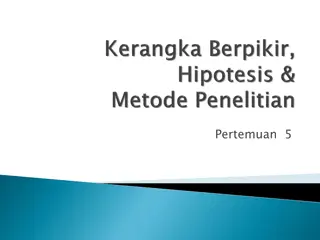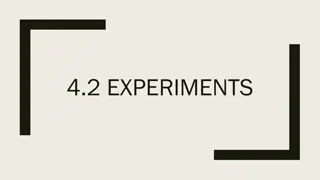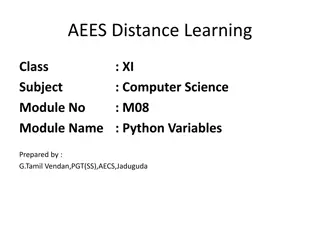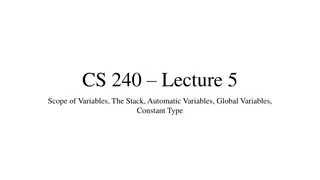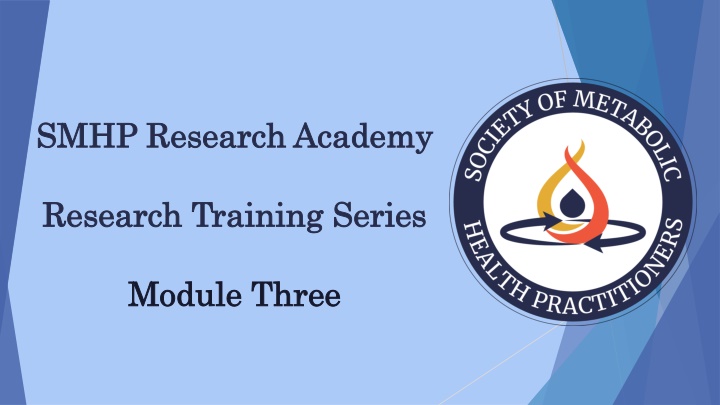
Research Study Designs, Variables, and Correlation
Explore types of research study designs, definitions of dependent and independent variables, examples, and the concepts of association and correlation in research. Join the Society of Metabolic Health Practitioners' Research Training Series to enhance your knowledge in research methodology.
Download Presentation

Please find below an Image/Link to download the presentation.
The content on the website is provided AS IS for your information and personal use only. It may not be sold, licensed, or shared on other websites without obtaining consent from the author. If you encounter any issues during the download, it is possible that the publisher has removed the file from their server.
You are allowed to download the files provided on this website for personal or commercial use, subject to the condition that they are used lawfully. All files are the property of their respective owners.
The content on the website is provided AS IS for your information and personal use only. It may not be sold, licensed, or shared on other websites without obtaining consent from the author.
E N D
Presentation Transcript
SMHP Research Academy SMHP Research Academy Research Training Series Research Training Series Module Three Module Three
The Society of Metabolic Health Practitioners The Society of Metabolic Health Practitioners Research Training Series Research Training Series Module Three Module Three Study Design and Definition of Variables Study Design and Definition of Variables Presented By: Dr. Melanie M. Tidman DHSc, MA, OTR/L, MHP 2
Research Training Video Modules Research Training Video Modules Module One Module One Preparing a Clinical Question for Investigation: What is a PICO(T) Preparing a Clinical Question for Investigation: What is a PICO(T) Module Two Module Two Reference Software and Reference Database Management Reference Software and Reference Database Management Module Three Module Three Study Design and Definition of Variables Study Design and Definition of Variables Module Four Module Four The Role of the IRB and Types of Review The Role of the IRB and Types of Review Module Five Module Five Evaluating the Quality of Research Articles Evaluating the Quality of Research Articles Module Six Module Six The Application of the PDSA Project Model The Application of the PDSA Project Model Module Seven Module Seven Types of Research Articles Types of Research Articles Module Eight Module Eight A Brief Review of R, SPSS and Python for Data Analysis A Brief Review of R, SPSS and Python for Data Analysis Module Nine Module Nine The Search for a Journal and Navigating the Author Guidelines The Search for a Journal and Navigating the Author Guidelines Module Ten Module Ten Preparing the Manuscript Preparing the Manuscript 3
Objectives Objectives Discuss Types of Research Study Designs Discuss Types of Research Study Designs Discuss the Definitions of Dependent and Independent Discuss the Definitions of Dependent and Independent Variables Variables Discuss Examples of Dependent and Independent Discuss Examples of Dependent and Independent Variables Variables Discuss Association and Correlation Discuss Association and Correlation 4
Main Types of Research Design Main Types of Research Design Observational Studies Also Known as Descriptive Studies Experimental Research Also Known as Interventional Research
Observation Studies Research Design Observation Studies Research Design Also Known as Descriptive Studies Different Types: Cross Sectional - a single interaction with a target population to note the status of a variable. Longitudinal - the study of the same individuals over time.
Observational Descriptive Design: Observational Descriptive Design: Survey Method Example Survey Method Example Group A - Higher rates of Cancer Higher rates of smoking Most delay annual checkups or skip healthcare appointments Toxico Chemical Plant located in this community Group B - Lower rates of Cancer Lower rates of smoking Largest employer is a Department store Residents delayed or skipped healthcare appointments.
Experimental or Interventional Research: Experimental or Interventional Research: Example One Example One Group A: Experienced a Telehealth appointment method in which nutrition and health was taught. Group B: Taught the same lessons about nutrition and health using a face-to-face format and standard teaching methods. Analysis of Variables: Biomarkers (BMI, HbA1C, Triglycerides, HDL, Fasting Insulin, and hs-CRP) Data Collection: At Baseline and 12 weeks Results: The biomarkers for patients in Group A improved the same as or similar to the patients in Group B who received the standard face-to-face teaching method.
Experimental Research Experimental Research Four Main Components (in general): Manipulation of Variables Control Groups or Standard of Care Groups Intervention Groups Participant Random Assignment or Random Selection (ori.hhs.gov, 2024).
Experimental or Interventional Research: Experimental or Interventional Research: Example Two Example Two Group A: Females with Osteoporosis who receive high-dose vitamin D supplements (5,000 IUs) daily for 6 months Group B: Females with Osteoporosis who receive the placebo (sugar pill) daily for 6 months. Data Collection Measures: The Dexa scans with T-Scores at baseline and after 6 months Results: Differences in Dexa Scan T-Scores indicated slight improvements in T-Scores in Group A when compared with Group B. Conclusion: High-dose Vitamin D supplements may contribute to improvements in T-Scores on Dexa Scans after 6 months.
Types of Research Variables Types of Research Variables Independent Variables These variables (also called the Intervention) can be systematically manipulated by the investigator. (Penslar & Porter, 2001). Example: A Low Carbohydrate/Ketogenic Diet Dependent Variables Variables that are influenced or expected to change as a result of the intervention (Penslar & Porter, 2001 ). Example: Symptoms of Hypertension
Associations, Correlations, Associations, Correlations, and Cause & Effect and Cause & Effect 12
Associations Associations Definition: Investigates the relationship of variables to each other and attempts to identify the nature of the relationship. Examples of Variable Sets: Height and Weight Blood Pressure and Congestive Heart Failure Exercise and Weight Loss Associations can be Positive or Negative.
Positive and Negative Associations Positive and Negative Associations Positive Associations: when one variable increases, the comparison variable also increases Examples: As height increases so does weight. As blood pressure levels increase, so does the risk of heart failure. Negative Associations: when one variable increases, the other variable decreases OR vice versa (inverse relationship). Examples: As exercise increases and weight decreases. As employer-based health and wellness programs increase, chronic illnesses among employees decrease.
Correlation: Indicates Linear Relationships Correlation: Indicates Linear Relationships Correlation Type Variable Relationship Example As sugar consumption increases, H bA1C also increases. Variables change together in the same direction as one increases so does the other and vice versa. Positive Correlation As coffee consumption increases, sleep quality decreases. Variables change together but in opposite or inverse directions as one increases the other decreases and vice versa. Negative Correlation Zero/No Correlation Shoe size is not correlated with salary. Variables have no correlation
Example of Association in Research Example of Association in Research The Ketogenic Diet (KD) has a Negative Association with: Biomarkers of Health Symptoms of Parkinson s Disease, Improving Nonmotor Daily Living Experiences Depression Anxiety As adherence to the KD increased, HbA1C, Triglycerides, Fasting Insulin, hs-CRP, and nonmotor symptoms of Parkinson s Disease decreased.
Association is Not Causation Association is Not Causation Association: Indicates a relationship between two or more variables. They may be coincidental, affected by other unknown variable(s), and require further research to be supported. Causation: Means one variable caused a direct effect on another variable. (SUDC Foundation, 2024).
Summary Summary Independent Variables can be systematically manipulated or Independent Variables can be systematically manipulated or changed in an experiment. changed in an experiment. Dependent Variables are variables that are influenced or Dependent Variables are variables that are influenced or expected to change as the result of an intervention expected to change as the result of an intervention the result the result of an experiment. of an experiment. Positive Associations/Correlations are when one variable Positive Associations/Correlations are when one variable increases, the comparison variable also increases. increases, the comparison variable also increases. Negative Associations/Correlations are when one variable Negative Associations/Correlations are when one variable increases, the other variable decreases OR vice versa. increases, the other variable decreases OR vice versa. Association is (in general) when there is a relationship Association is (in general) when there is a relationship between two or more variables, however Causation is when one between two or more variables, however Causation is when one 18 variable causes a direct effect on another variable. variable causes a direct effect on another variable.
References References Gupta, Aryan (2024). What Is Correlation? A Guide for Beginners. Simplilearn.com. https://www.simplilearn.com/tutorials/statistics-tutorial/what-is-correlation-in-statistics. Office of Research Integrity (2024). Research Handbooks and Guidelines. US Department of Health and Human Services. https://ori.hhs.gov/content/handbooks-and-guidelines Oxford Center for Evidence Based Medicine (March 2009). CEBM Levels of Evidence. https://www.cebm.ox.ac.uk/resources/levels-of-evidence/oxford-centre-for-evidence-based- medicine-levels-of-evidence-march-2009 SUDC Foundation (2024). Being a Critical Consumer of Medical Research: Understanding Association versus Causation. https://sudc.org/being-a-critical-consumer-of-medical-research- understanding-association-versus-causation/ 19
Acknowledgements Acknowledgements Sincere Thanks to the Society for Metabolic Health Practitioners for their support of this Research Training Series A/V Editing & Tech Support: Bryson Tidman PowerPoint/Graphic Design: Kathryn Tidman 20
SMHP Research Academy SMHP Research Academy Research Training Series Research Training Series Module Three Module Three


